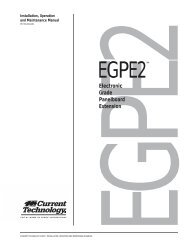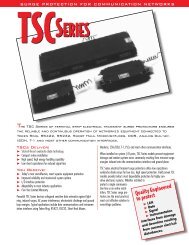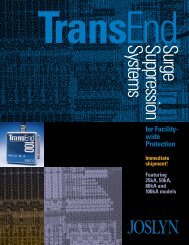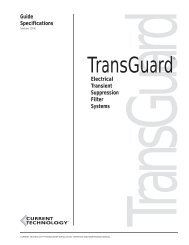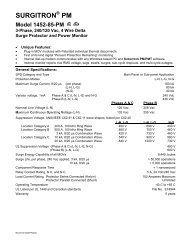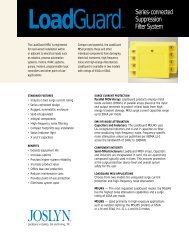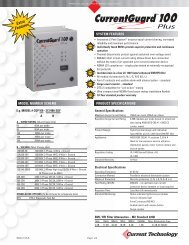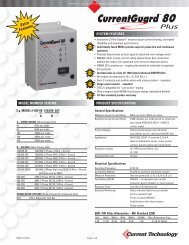overview PDF - Power & Systems Innovations
overview PDF - Power & Systems Innovations
overview PDF - Power & Systems Innovations
You also want an ePaper? Increase the reach of your titles
YUMPU automatically turns print PDFs into web optimized ePapers that Google loves.
SF150 INSTALLATION<br />
INSTRUCTIONS<br />
1. Voltage Verification<br />
Prior to product installation, verify that the voltage rating of the intended<br />
electrical service matches the voltage rating of the unit to be installed.<br />
Warning: serious injury or damage can result from installing a product<br />
with an improper voltage rating. Contact Current Technology if voltage ratings<br />
are not identical. For WYE connected systems, verify neutral-ground<br />
bond on secondary side of upstream distribution or service entrance transformer.<br />
Warranty void if SF150 is connected to incorrect voltage configuration<br />
or if neutral-ground bond is not present in WYE configured systems.<br />
2. Installation Location<br />
To minimize installed system impedance, install SF150 in a location that minimizes<br />
electrical wire bends and wiring distance from point of connection.<br />
3. Mounting<br />
Utilizing the mounting feet and hardware supplied with the unit, mount the<br />
SF150 securely and rigidly to building surface or structural member. Attach<br />
conduit and pull wires as necessary.<br />
4. Electrical Connections<br />
VERIFY THAT POWER IS DE-ENERGIZED ON ELECTRICAL LINES<br />
ASSOCIATED WITH INSTALLATION OF THIS UNIT. SF150 units without<br />
integral overcurrent protection must be installed in parallel with the electrical<br />
distribution system via a fused disconnect switch or circuit breaker. Fuses<br />
or circuit breakers rated for 60A or less must be used. Use #4 to #2 AWG copper<br />
wire for parallel phase conductor connections. Use a #4 to #2 AWG copper<br />
wire for neutral (N) and ground(EG) connections (no neutral (N) for<br />
DELTA configurations). Tighten lugs securely to a maximum torque of 52 inlb.<br />
Caution: B phase must be the high leg for high leg DELTA configured<br />
products installed on high leg DELTA systems. Contact factory for other<br />
voltage configurations not listed on this technical data sheet.<br />
5. Fused Disconnect Option<br />
SF150 models are available with integral fused disconnect switch that permits<br />
direct connection in parallel with the electrical distribution system without<br />
utilizing an additional external fused disconnect switch or circuit breaker.<br />
Use #4 to AWG copper wire for parallel phase conductor connections to<br />
fused disconnect terminals (L1, L2, L3). Use a #4 to #2 AWG copper wire for<br />
neutral (N) and ground (EG) connections (no neutral (N) for DELTA configurations).<br />
Tighten lugs of fused disconnect to a maximum torque of 35 in-lb<br />
and 52 in-lb. for neutral (N) and ground (EG).<br />
6. Remote Monitor Contacts Option<br />
SF150 models are available with two sets of form “C” remote monitor dry contacts<br />
that may be connected to building management systems or remote<br />
annunciation alarm panels. To wire dry contacts, locate the output terminals<br />
mounted on the dry contact circuit board. Each set of contacts may be wired<br />
independently. Each set of form “C” contacts includes common (C), normally<br />
open (NO) and normally closed (NC) contacts. For normally open operation<br />
under energized conditions, connect the normally open terminal and common<br />
terminal to the monitoring input. For normally closed operation during<br />
energized conditions, connect the normally closed terminal and common terminal<br />
to the monitoring input. Upon loss of power to any or all phases, contacts<br />
will change to alarm state.<br />
7. StatusWatch Option<br />
SF150 models are available with StatusWatch diagnostic monitoring.<br />
StatusWatch includes status indicator lights, battery powered audible alarm<br />
with test and disable functions, two sets of form “C” remote monitor dry contacts<br />
and optional disturbance counter(s). Battery is field replaceable, standard<br />
9V alkaline. To activate battery, remove isolation strip between battery<br />
and terminal and push battery firmly into battery holder terminals.<br />
To test audible alarm, press alarm test push-button: alarm should sound and<br />
alarm/test indicator should flash. Alarm may be silenced by moving toggle<br />
switch into upper position; alarm disable indicator will illuminate.<br />
To wire dry contacts, locate the output terminals mounted on dry contact circuit<br />
board. Each set of contacts can be wired independently. For normally<br />
open operation under energized conditions, connect the normally open terminal<br />
and common terminal to the monitoring input. For normally closed operation<br />
during energized conditions, connect the normally closed terminal and<br />
common terminal to the monitoring input. Upon loss of power to any or all<br />
phases, contacts will change to alarm state.<br />
StatusWatch is available with dual disturbance counter(s) that measure the<br />
number of Line-to-Neutral and Line-to-Ground transients occurring in WYE<br />
configurations. For DELTA systems, a single counter measures Line-to-Line<br />
transients. To reset counters, remove connector on the back of each counter<br />
and short pins 1 and 3.<br />
8. Before energizing SF150<br />
Check all connections to ensure solid electrical connection. Tighten any loose<br />
connections to appropriate torque values.<br />
Measure voltage Line-to-Line, Line-to-Neutral, Line-to-Ground and Neutralto-Ground<br />
to ensure that it does not exceed ±10% of the nominal rated voltage<br />
for the unit. Contact factory if these tolerances are exceeded.<br />
9. Final Instructions<br />
If all voltages are in tolerance, replace the cover of the unit and tighten fastening<br />
screws. Apply power to the unit by engaging the appropriate fused disconnect<br />
switch or circuit breaker. Illumination of status indicator lights indicates<br />
proper function.<br />
10. Diagnostic Testing<br />
In the unlikely event of unit’s overcurrent protection opening, unit should be<br />
tested with a DTS-2 Diagnostic Test Set to verify operational integrity. To test,<br />
locate test point and disconnect from wiring harness. Follow DTS-2<br />
Diagnostic Test Set instructions. If the test results are within factory specified<br />
tolerances, replace or reset overcurrent protection. IF TEST RESULTS<br />
ARE NOT WITHIN FACTORY SPECIFIED TOLERANCES, DO NOT<br />
REPLACE OR RESET OVERCURRENT PROTECTION PRIOR TO CON-<br />
TACTING CURRENT TECHNOLOGY’S “24X7” TECHNICAL SERVICE<br />
HOTLINE AT 1-888-200-6400. Reconnect test point to wiring harness upon<br />
completion of testing and prior to re-energizing.<br />
Current Technology, Inc. • 3001 W. Story Road, Irving, TX 75038 • 1-800-238-5000 • 214-252-7705 fax<br />
© 1998 Current Technology, Inc. All rights reserved. 8.96/10M-Rev. 1



